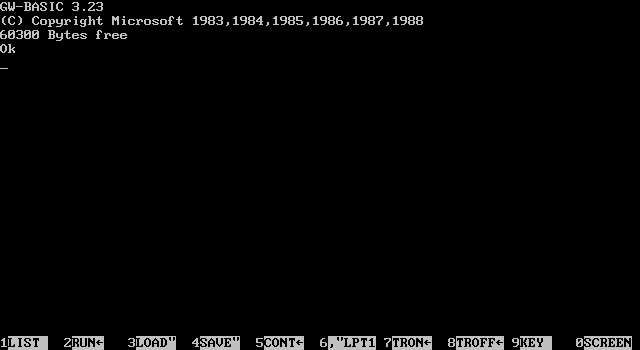 GW-BASIC
GW-BASICExplore Microsoft’s classic BASIC interpreter for DOS. Learn commands, syntax, and how to run GW-BASIC on modern Windows systems.
GW-BASIC is compatible with Microsoft/IBM BASICA, but was disk based and did not require the ROM BASIC.
Microsoft bundled GW-BASIC with MS-DOS operating systems on IBM PC compatibles.
Microsoft also sold a BASIC compiler, BASCOM, compatible with GW-BASIC, for applications requiring more speed.
The language was suitable for simple games, business programs and the like.
Since it was included with most versions of MS-DOS, it was also an inexpensive way for many would-be programmers to learn the fundamentals of computer programming.
With the release of MS-DOS 5.0, QBasic,
a cut-down version of the separately available QuickBASIC
compiler, took eventually GW-BASIC's place.
|

Appeared in 1983
Developer: Microsoft (for Compaq)
Latest release: 3.23/1988
Paradigm: Imperative, high-level
Influenced by IBM Cassette BASIC,
IBM Disk BASIC,
IBM BASICA
Influenced: QBasic,
QuickBasic
OS: DOS
Example: 10 CLS 20 PRINT "Hello, world!" 30 END
GW-BASIC has a command line-based Integrated Development Environment
(IDE) based on Dartmouth BASIC.
It also includes function key shortcuts at the bottom of the screen.
Like other early microcomputer versions of BASIC, GW-BASIC lacked many of the structures needed for
structured programming such as local variables, and GW-BASIC programs executed relatively slowly,
due to the fact that it was an interpreted programming language.
All program lines must be numbered, all nonnumbered lines are considered to be commands in direct mode to be executed immediately.
The format of program source files is normally binary compressed with tokens replacing commands, or optionally ASCII text form.
The GW-BASIC command-line environment has commands to RUN, LOAD, SAVE,
LIST the current program, or quit to the operating SYSTEM;
you can use these commands also as program statements.
There is little support for structured programming in GW-BASIC.
All IF/THEN/ELSE conditional statements must be written on one line, although WHILE/WEND
statements may group multiple lines.
Functions can only be defined using the single line DEF FNf(x)='mathematical function of x' statement
(e.g., DEF FNLOG(base,number) = LOG(number) / LOG(base)).
The data type of Variables can be specified with a character at the end of the variable name: A$ is a string
of characters, A% is an integer, etc.
Groups of variables can also be set to default types based on the initial letter of their name by using the DEFINT, DEFSTR, etc., statements.
The default type for undeclared variables not identified by such typing statements, is single-precision floating-point.
GW-BASIC allowed for the joysticks, mice and light pen input devices of its time.
GW-BASIC can read from and write to files and COM ports; it can also do event trapping for ports.
Since the cassette port interface of the original IBM PC was never implemented on compatibles, cassette operations are not supported.
GW-BASIC is able to play simple music using the PLAY statement, requiring a string of notes represented in a music macro language
(e.g. PLAY "edcdeee2dfedc4").
More low-level control is possible with the SOUND statement,
which takes the arguments of a hertz frequency and a length in clock ticks played through the standard internal PC speaker in IBM machines.
Consequently sound is limited to single channel beeps and whistles as befits a 'business' machine.
Home based PCs such as the Tandy 1000, allowed up to three channels of sound for the SOUND and PLAY commands.
|
|
|
 GW2ASC 1.02 for Windows - GW-BASIC Binary to ASCII source code converter
GW2ASC 1.02 for Windows - GW-BASIC Binary to ASCII source code converter
Yes. You can use DOSBox or PC-BASIC to emulate the environment easily (See above).
GW-BASIC is old and not used much today. It was a popular programming language in the 1980s and early 1990s for MS-DOS computers. Today, newer and better languages have replaced it. However, some hobbyists still try it for fun or learning. They often run it on special programs called emulators or on old computers.
Yes (See above).
QBasic is a simple programming language made for beginners, created by Microsoft. It is a better and more modern version of GW-BASIC. It has an easy-to-use design, a built-in editor, and tools to find and fix mistakes.
Explore thousands of classic BASIC source code examples. Algorithms, games, compilers, DOS, graphics & more — all free.